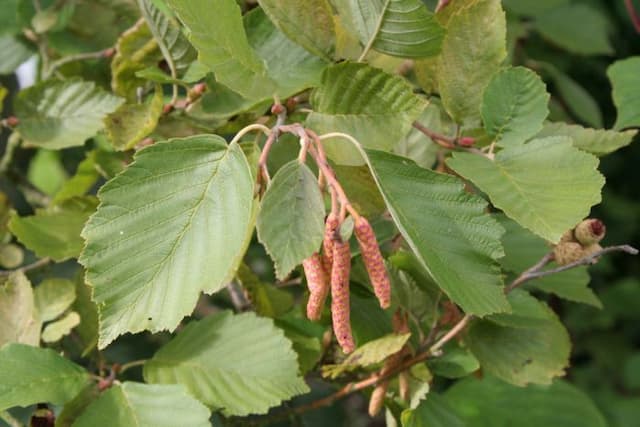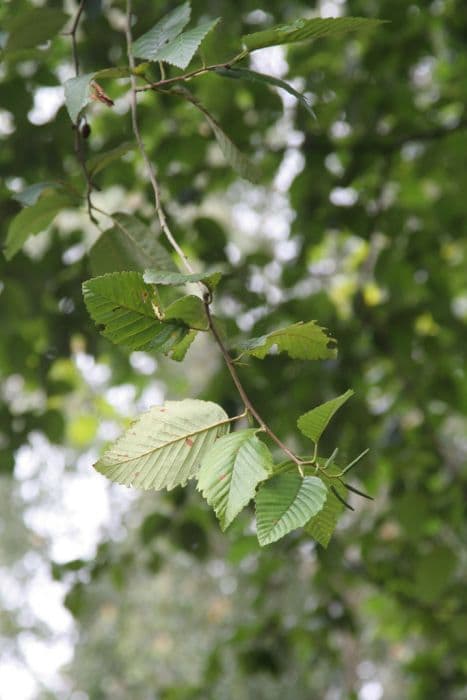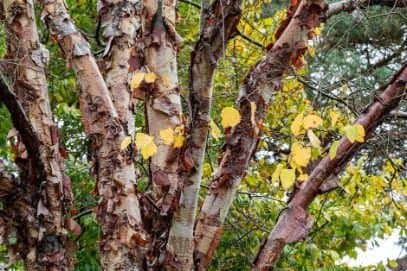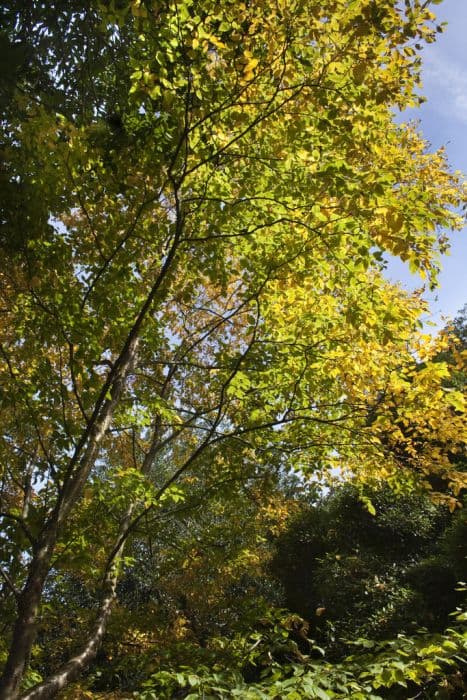Chinese Red Birch Betula utilis subsp. albosinensis 'Bowling Green'

ABOUT
The plant commonly known as the Chinese red birch features particularly attractive bark, which is a prominent characteristic of this cultivar. The bark peels away in delicate sheets, revealing a play of colors that can range from creamy white to rich cinnamon-brown. This exfoliating bark provides year-round interest and a striking look in the garden landscape. The leaves of the Chinese red birch are oval to diamond-shaped, with a point at the tip and a jagged edge. The foliage is a fresh green color that turns yellow in the fall, providing seasonal interest. The plant produces catkins, which are long, cylindrical flower clusters that add a soft texture to its appearance. In the case of the Chinese red birch, these catkins hang gracefully from the branches, lending a delicate charm to the tree's overall aesthetic. Despite the restriction on mentioning size, it is important to note that the overall appearance of the Chinese red birch is one of elegance and grace, with its beautiful bark and pleasant foliage making it a desirable plant for ornamental purposes. Its adaptability to various garden settings allows it to be incorporated into many landscape designs, adding both beauty and character.
About this plant
 Names
NamesFamily
Betulaceae.
Synonyms
Chinese Red Birch, Chinese Silver Birch, Red Birch.
Common names
Betula utilis var. prattii, Betula albosinensis var. septentrionalis.
 Toxicity
ToxicityTo humans
The plant commonly known as Birch is typically not considered poisonous to humans. There are no well-documented cases of toxicity from ingestion of parts of this plant. Therefore, accidental ingestion is unlikely to cause serious harm or symptoms of poisoning in humans.
To pets
Birch trees are generally not toxic to pets. They should be safe for dogs, cats, and other domestic animals. If a pet ingests part of a Birch tree, they are unlikely to experience any significant toxic effects. However, it is always wise to monitor your pet and consult with a veterinarian if you notice any unusual behavior or symptoms following ingestion.
 Characteristics
CharacteristicsLife cycle
Perennials
Foliage type
Deciduous
Color of leaves
Green
Height
30 feet (9 meters)
Spread
20 feet (6 meters)
Plant type
Tree
Hardiness zones
7
Native area
China
Benefits
 General Benefits
General Benefits- Ornamental Value: The plant is known for its attractive bark, which peels off in various shades of white, pink, and copper, enhancing the visual appeal of gardens and landscapes.
- Wildlife Habitat: Provides shelter and nesting sites for birds and other small wildlife.
- Shade Provision: Can be used as a shade tree in gardens and parks, offering a cool area during sunny days.
- Windbreak: Acts as a barrier against strong winds, thereby protecting smaller plants and reducing soil erosion.
- Seasonal Interest: Exhibits seasonal changes that add interest to the landscape, with foliage turning yellow in the autumn.
 Medical Properties
Medical Properties- This plant is not used for medical purposes.
 Air-purifying Qualities
Air-purifying QualitiesThis plant is not specifically known for air purifying qualities.
 Other Uses
Other Uses- Betula utilis, commonly known as Himalayan birch, can be used in furniture making due to its sturdy and attractive wood.
- The bark of the Himalayan birch can be utilized in crafting, specifically in making birch bark canoes or containers, as it is flexible and water-resistant when treated properly.
- Himalayan birch wood, due to its durability, is used for interior paneling, giving rooms a warm, rustic appearance.
- The decorative peeling bark of Himalayan birch can be incorporated into landscape design as a natural mulch, helping to suppress weeds and retain soil moisture.
- Himalayan birch sap can be tapped and used as a base for syrups and beverages, similarly to how maple sap is used.
- Fine-grained wood from the Himalayan birch is suitable for carving and woodturning, making it a popular choice for artists and craftsmen.
- The tree's ability to grow in cold climates makes it an important windbreak and shelterbelt tree in high-altitude and northern regions.
- Himalayan birch leaves can be used as a natural dye for fabrics, yielding colors ranging from pale yellows to rich greens depending on the mordant used.
- The tree is also planted for ornamental purposes, as it has a striking appearance throughout the seasons with its white bark and changing foliage.
- Dried branches and twigs of the Himalayan birch are used in floral arrangements and decorative crafts due to their aesthetic appeal.
Interesting Facts
 Feng Shui
Feng ShuiThe Chinese Red Birch is not used in Feng Shui practice.
 Zodiac Sign Compitability
Zodiac Sign CompitabilityThe Chinese Red Birch is not used in astrology practice.
 Plant Symbolism
Plant Symbolism- Growth: Betula utilis, commonly known as the Himalayan Birch, often symbolizes new beginnings and growth due to its hardy nature and ability to thrive in challenging conditions.
- Renewal: The peeling bark of the Himalayan Birch represents renewal and the cyclical aspect of nature, as it sheds its outer layers to reveal new growth beneath.
- Purity: The white bark of this birch variety is associated with purity and cleanliness, offering a sense of clarity and simplicity.
- Adaptability: Its ability to adapt to various climates reflects the symbolism of adaptability to changing circumstances in a person's life.
- Protection: In many cultures, birch trees have been thought to ward off evil and protective energies are attributed to them due to their longevity and resilience.
 Water
WaterFor the Chinese Red Birch (Betula utilis subsp. albosinensis 'Bowling Green'), water thoroughly when the top inch of soil feels dry, typically once or twice a week, depending on weather conditions. During the growing season, this may equate to 1 to 2 gallons per week for younger trees, and for established trees, deep watering every two weeks with 5 to 10 gallons may be appropriate. It's best to water the tree directly at the base, avoiding overhead watering to reduce the risk of leaf diseases.
 Light
LightThe Chinese Red Birch prefers full sun to partial shade, meaning the ideal spot would receive direct sunlight for at least 6 hours each day. It can tolerate light shade, especially during the hottest part of the day, but the best growth occurs in a location that is sunny and bright.
 Temperature
TemperatureThe Chinese Red Birch is hardy and can withstand a wide temperature range, surviving winter lows down to -30°F and flourishing in summer highs up to 80°F. Nonetheless, the ideal temperature range for this birch is between 50°F and 70°F, providing a temperate environment for optimal growth.
 Pruning
PruningPrune the Chinese Red Birch during its dormancy in late fall or winter to remove any dead, diseased, or crossing branches and to maintain its shape. Pruning every 2 to 3 years is usually sufficient. The best time for major pruning is before the spring growth starts, but limited pruning can be done anytime if necessary.
 Cleaning
CleaningAs needed
 Soil
SoilThe Chinese Red Birch prefers a well-drained, loamy soil with a pH ranging from 6.0 to 7.5. The best soil mix is one part garden soil, one part peat moss or compost, and one part perlite or coarse sand for improved drainage.
 Repotting
RepottingThe Chinese Red Birch, being a large tree, does not require frequent repotting. It is typically planted directly into the ground and does not need to be repotted unless grown in a very large container or for bonsai practices.
 Humidity & Misting
Humidity & MistingChinese Red Birch thrives in areas with average humidity levels. It does not require high humidity and can tolerate the natural humidity levels found in most temperate outdoor climates.
 Suitable locations
Suitable locationsIndoor
Not ideal for indoor growth; needs full sun, ample space.
Outdoor
Plant in full sun, well-drained soil; water regularly.
Hardiness zone
6-9 USDA
 Life cycle
Life cycleThe life cycle of the Paperbark maple (Betula utilis subsp. albosinensis 'Bowling Green') begins with seed germination, which occurs when temperatures rise in spring and adequate moisture is present. After sprouting, the seedling grows into a juvenile plant, developing a basic root system and foliage. In its sapling stage, the tree rapidly increases in height and girth, with its distinctive peeling bark becoming more pronounced as it matures. The tree reaches maturity around 20 to 30 years, at which point it begins to flower and produce seeds, thus capable of reproduction. During its reproductive phase, it produces catkins that release pollen and ovules for fertilization. After many decades, the tree eventually enters senescence, slowing its growth and becoming less vigorous before ultimately dying.
 Propogation
PropogationPropogation time
Late Summer to Autumn
Propogation: The Betula utilis subsp. albosinensis 'Bowling Green', commonly referred to as the Chinese Red Birch, is propagated primarily through seed collection and sowing. The ideal time for seed collection is late summer to autumn when the seeds are mature. To propagate by seed, one should first collect the seed catkins when they begin to disperse naturally. Once collected, the seeds can be sown immediately or stored in cool conditions until the following spring. Sow the seeds thinly on a well-drained seedbed, and lightly cover them with soil. Germination can be somewhat erratic, but you should expect seedlings to emerge several weeks after sowing. Thin out the seedlings once they are large enough to handle, and with proper care, they will grow into healthy saplings that can be transplanted to their final location.









